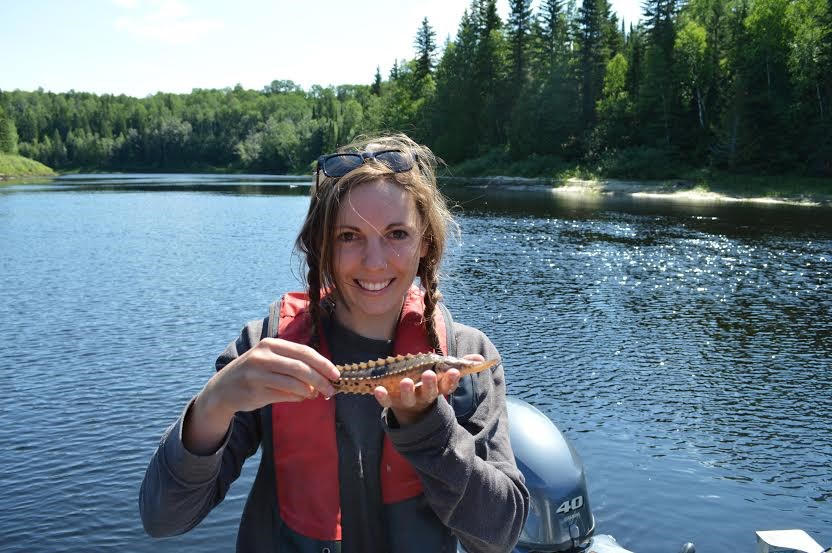In Part 2 of my look at the Mattagami River Sturgeon Restoration Project I reached out to Maggie Boothroyd to answer some questions so we could have little better insight and understanding as to when the project started, what was involved in this project and why it is being done.
*************************
Q When did the netting project on the lake sturgeon begin?
A There have been two netting efforts prior to my involvement in the project.
One occurred in 2011 and one in 2013.
The goal of these netting efforts was to insert radio tags into a portion of the juveniles and adults in the population.
This resulted in the radio tagging of seven juveniles and eight adults.
These tagged fish have been tracked manually (from a receiver within the boat), and using stationary monitors set up along the edges of the river.
The netting effort that I have led started in spring of 2015 and consisted of three netting periods.
The spring effort was a week long and targeted adult sturgeon.
The July effort was two weeks long and targeted juvenile sturgeon.
During both efforts all sturgeon caught were tagged.
The netting effort I am currently conducting is randomised throughout the river, with the end goal being a population abundance estimate (which requires a certain number of recaptures that were tagged during the previous efforts).
Q Were you involved with the project from the start in 2002 or did you join later and if later when?
A I became involved in this project September 2014.
Q What is your part in this project and position?
A I am a Trent University M.Sc. candidate, and my research thesis is based around assessing the lake sturgeon reintroduction.
Q How many times a year do you do your netting?
A I netted three times this year, this will conclude my netting effort. There are no plans for any more netting in the near-future.
Q What type of methods were used to capture the sturgeons and how many were used?
A I sample for sturgeon using a combination of gillnets (one to target adults and one to target juveniles), and trotlines (which are weighted lines with 18 hooks. In this effort I have 12 sets out (4 of each type mentioned)).
Q Were they used throughout the river system from the Wawaitin Dam to the Sandy Falls Dam?
A The first two sampling efforts were targeted. This effort will sample throughout the entire stretch from Wawaitin to Sandy Falls.
Q After capturing a sturgeon what did you do with it?
A For every sturgeon we take length and weight measurements, we also tag them using two tag types.
Firstly, we use external tags, which can be seen near the tail of the fish.
There is a certain amount of tag loss associated with external tags.
So secondly, passive integrated transponders (PIT) tags which are located just beneath the skin, and each tag reads out as a unique code.
Additionally, we take a clip of the left pectoral fin, which we use to age the fish and for genetics.
The tagging allows us to know when we have a recapture, which is necessary for population size estimation.
The age and size data is important for growth information, which can be used to compare the reintroduced population to other sturgeon populations.
Q Did you capture or have you captured different year classes since the first sturgeons were introduced to the river?
A Yes, we have captured a number of year classes, the year classes of the juveniles caught thus far appear to be from 2007-2014.
Q Would you say that the sturgeon are reproducing?
A Yes, the sturgeon are reproducing.
Q When will the studies be done on the sturgeons? What year?
A My M.Sc is expected to be completed late fall 2016.
Q When will the study be available for the public to review?
A I anticipate it will be available to the public December 2016.
Q Why were the sturgeon transplanted back into the river system?
A The sturgeon were reintroduced to the river because they are a species at risk, and the recovery goals for species at risk state that the species should be reintroduced into areas of original occurrence where they have been extirpated.
This section of river was a good candidate as the reasons the sturgeon had originally declined (overfishing, pollution) has been mitigated.
The human-mediated movement was required as the habitat has been fragmented by hydroelectric development, so natural recolonization was not a possibility.
Fish passages are effective for some species. Unfortunately lake sturgeon is not one of them.
*************************
Maggie states that the MNRF, Timmins Fur Council, Club Navigateur La Ronde, Ontario Power Generation, Glencore, Lakeshore Gold and Mattagami Region Conservation Authority, are funding the project, as well as aiding the field work.
Maggie would like to specifically thank Kevin Roy from the Fur Council (Fall Netting 005) and Larry Robichaud from Club Navigateur La Ronde as they have been extremely committed in aiding her in her work this year and the two regional MNRF summer students: Emma Harten and Adam Rupnik.
It was a real pleasure to have had this opportunity to learn more about the Sturgeon Project and to have met such a passionate young lady that was doing this study.
Maggie is targeted to defend her thesis in December 2016.
Although Maggie's plans after her thesis is finished are still up in the air, she is leaning towards doing 8-12 months volunteering for a marine conservation group.
After that, she plans to start looking for a job in the conservation field.
I wish Maggie all the best in her endeavors and know that where ever she ends up, she will continue to bring that passion she possess.
Whether you're an angler or hunter; a camp, lodge, resort owner; or just holding an outdoor event and would like some exposure, please feel free to email us at [email protected]

